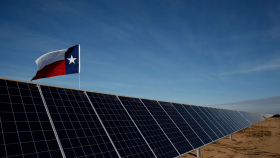The solar photovoltaic (PV) effect is the process by which sunlight is converted directly into electricity. In 1839, Edmond Becquerel, a French physicist, discovered the process of producing an electric current in a solid material using sunlight. But it wasn’t until 1954 that scientists at Bell Telephone discovered that, when exposed to sunlight, silicon created an electric charge.
Photovoltaic energy has been used to power small items like wristwatches and calculators. But there are ways to use solar PV technology to generate electricity on a much larger scale:
Monocrystalline silicon, polycrystalline silicon and thin film solar panels use small squares – cells – of conductive material to produce electricity for homes and businesses.
Photovoltaic cells are combined onto a panel (also called a module). A collection of panels is referred to as an array. Learn more about types of solar panels.
Concentrated photovoltaics are used for large-scale applications. These use mirrors to direct sunlight to a very small area of highly efficient photovoltaic material. In concentrating solar power systems, the sunlight is converted to heat energy, which is then used to drive a generator or steam turbine.
Learn more about the advantages of solar energy.





